Volterra, a true and largely unknown gem of Tuscany, gives an authentic view of life in Italy. Volterra doesn’t disappoint. It has a timeless charm, displays the full range of Italian history, and has a peaceful serenity that pleads for my return. The dreamy Tuscan town is perched on top of a hill, with stunning views of the Tuscan countryside, and on a good day you can see the Ligurian Sea. Volterra is certainly off-piste.
Volterra is a location many don’t know about as I’m sure many ignore the beauty of this place and opt for a visit to the more famous San Gimignano, for example. Ignore might be a wrong choice of word – blissfully unaware is more apt a description. Their loss is most definitely my gain, although I wish I had given more time to the place.
When planning any trip to Tuscany it certainly doesn’t appear (or, in my case, didn’t) high on a list of places to visit. Florence, Pisa, Lucca, Sienna, San Gimignano etc. all lay claim to showcase the beauty of Tuscany. Whilst that list is impressive, and each one has their own claim, Volterra edges itself to the top of the list.
Arriving in Volterra
The long and winding road to Volterra meanders its way along and up to the top of a ridge. The town is perched on top of this ridge. As I leave the wet and rainy main road at the bottom, my view is obstructed by the low and dense clouds stuck to the hill like candy floss to a stick. But as I climb out of the clouds I have arrived. I quickly park the car and dash to the iconic viewpoint next to Piazza Martiri della Liberta.
The view is spectacular! A blanket of cloud sweeps across the Tuscan countryside trapping what is to view beneath it. The only blemish is another ridge in the distance just popping its head out. Volterra is bathed in sunshine and surrounded in blue skies. The contrast is stark. The Tuscan houses add a splash of colour as they radiate in the scorching sun.
I finally drag myself away from that glorious view and head towards Piazza dei Priori, a short walk from my starting point. The piazza is the medieval heart of the city and dominated on all sides by a combination of powerful civic buildings and palazzos. It is home to the city’s tourist information office which is the perfect place to grab a map, get some bearings and some helpful hints.
Piazza dei Priori – the heart of Volterra
The Palazzo dei Priori dominates the square, and you might say looks very similar in design to that of the Vecchio Palace in Florence. That’s because the Priori Palace is the oldest civic building in all of Tuscany (built in 1208). It is said that it provided inspiration for the design of Vecchio Palace in Florence. I confess I didn’t pay the entrance fee (to my regret) to be able to step inside the building – a shame as it would have allowed me to climb the clock tower for rewarding views over the city.
The exterior of the building is a sight to admire. Heraldic shields adorn the outside wall on the square. These shields represent the Medici commissioners who were charged with overseeing the town. During the Lorenzo the Magnificent control of Florence, the Medici (or Florence at the time) captured Volterra in 1472 after an uprising over alum mines (not to be confused with aluminium mining).
On the other sides of the square are the Palazzo Pretorio and the Torre del Porcellino, the Palazzo Vescovile (once a grain warehouse) and Palazzo Incontri. The square itself was rather peaceful on my visit. The glorious weather, though, was enticing me to explore the rest of the town. So, armed with my map, I set off in haste.
Cathedral of Santa Maria Assunta and the Baptistery
The city’s civic buildings were built close to the cathedral. As home to the powerful bishop these demonstrated the municipality’s supremacy and autonomy. I walked around the back of the Priori Palace to Piazza San Giovanni. This small and compact little square was dominated by the small and charming cathedral on one side and the baptistery on the opposite side with the ambulance station and the former civic hospital on the other two opposite sides.
The appearance of the cathedral is very basic. Plain and simple from the outside it shows its age with Romanesque / medieval architecture. Inside, similarities to the Cathedral in Pisa are on full display. Tall pillars line either side of the nave with rounded arches on top. There is a distinct lack of windows. The ceiling is decorated with a coffered ceiling (a decorative ceiling of sunken panels or coffers). Approval for this was granted by Ferdinando I de’ Medici in 1580.
Inside there are impressive pieces of artwork which include ‘Martyrdom of St Sebastian’ (Francesco Cungi – 1587), Wooden sculpture of the Deposition of Christ (Tuscan – 1228), ‘Birth of the Virgin (Francesco Curradi – 1618).
On the other side of the Piazza is the Baptistery. The black and white polychrome decorates the outside of the building. Inside is a vacuum of silence. The basic structure dates to before 1000 AD
Piazza Marcello Inghirami
After visiting the cathedral, I make my way to Piazza Marcello Inghirami to discover Cappella della Croce di Giorno. Whilst here I discover one of the old city gates – Porta San Francesco. In my haste to get here I completely miss Porta all’Arco which displays one of the main pieces of evidence of Etruscan period. Just as I arrive at the piazza, I notice the Chiesa di San Lino.
Chiesa di San Lino is named after the second pope of Christianity (Linus). It was built in 1480 by Raffaello Maffei. A single nave structure is very dark, intimate and private. It had connections with the adjoining monastery. The vaulted ceiling is decorated with frescoes.
After leaving the church I walk into the piazza. Immediately I notice a monument of two ladies. Unable to translate Italian, I had to cheat and use the internet. The limited research available tells me that these are monuments of Sante Attinia and Greciniana by Flavio Melani.
In the piazza at the top of some steps is Chiesa di San Francesco (namesake with the gate) with the beautiful Cappella della Croce di Giorno (Chapel of the Cross of Day) inside. This church, like the cathedral, is hardly recognisable as its simple nature is camouflaged in the surrounding buildings. The stunning chapel inside dates to the 13th century with a remarkable set of frescoes. These were completed by Cenni di Francesco in 1410 and depict Christ’s childhood, the life of Madonna and the Cross.
After admiring the impressive gates of Porta San Francesco I skirt around the town to one of the city’s famous sites.
Roman Theatre
The glory of Rome is on full display at the Roman theatre. Excavations in the 1950’s discovered the theatre. It was built around 1st century BC during the reigns of Augustus and Tiberius (recently mentioned in Rimini) for the Caecinae family. By the end of the 3rd century BC the theatre was abandoned, and thermal baths were built instead.
The theatre uses the natural incline of the hill to create the seating area – like those built by the Greeks. The thermal baths were added after the theatre was no longer used. They date to the late antiquity period. During medieval times the city’s wall was built through the middle of the site.
A visit is a must, although brief as access is restricted to a few certain areas. Information boards provide lots of information. It’s debateable whether to pay the entrance fee as the views from the surrounding area and pathways do provide good views of the ruins (without the information boards!!).
The Roman theatre isn’t the only ancient ruin in the city. Leave behind the Roman theatre and enter back into the city through Porta Fiorentina (another city gate – the Medici coat of arms sits above the gates), and head along Via Guarnacci past the Toscano Tower and Chiesa di San Michele Arcangelo back towards the city centre. At the end of Via Guarnacci pick up Giacomo Matteotti then Via di Castello.
Medici Fortress
You enter the Enrico Fiumi Archaeological Park, a pretty garden area in the city. Tucked away in one corner is the Etruscan Acropolis archaeological site. Sadly, this was closed by the time I arrived, but having looked at the reviews on internet I may have saved myself a few pennies. The feedback on the internet is that the site isn’t that impressive.
Leaving the ruins aside turn around and a view of the commanding Medici fortress awaits. This fortress fully displays the power of the Medici. The tower of the Medici fortress stands behind strong walls.
Sadly, after much walking around, I discover that access is not permitted to the fortress as it is still used as a prison. Admiration must be from afar with the internet providing the information and knowledge. Research tells me that the fortress was built in 1474 on the remains of an old fortress. Built two years after Florence had conquered the city, it was built to display the stranglehold the Medici had over the city and discourage any future rebellions and not for the protection of the city.
I leave the park and castle view and head off to find my accommodation (Hotel La Locanda) and a good Tuscan meal for the evening.
Volterra summary
For those wanting to avoid the crowds then this is the place to visit. Situated high above the clouds it offers spectacular views of Tuscany. It passes the Italian history test as evidence of all the great periods of the nation’s history are on display.
Evidence can be found of the Etruscan and Roman early settlement in two archaeological sites. There is a scattering of medieval architecture. Although not clear to begin with, the Medici family leaves its mark, their tentacles really do appear to spread far and wide. The charming city on a hill is a wonderful discovery; I hope I have inspired you to visit. It is certainly a place I would love to see again.

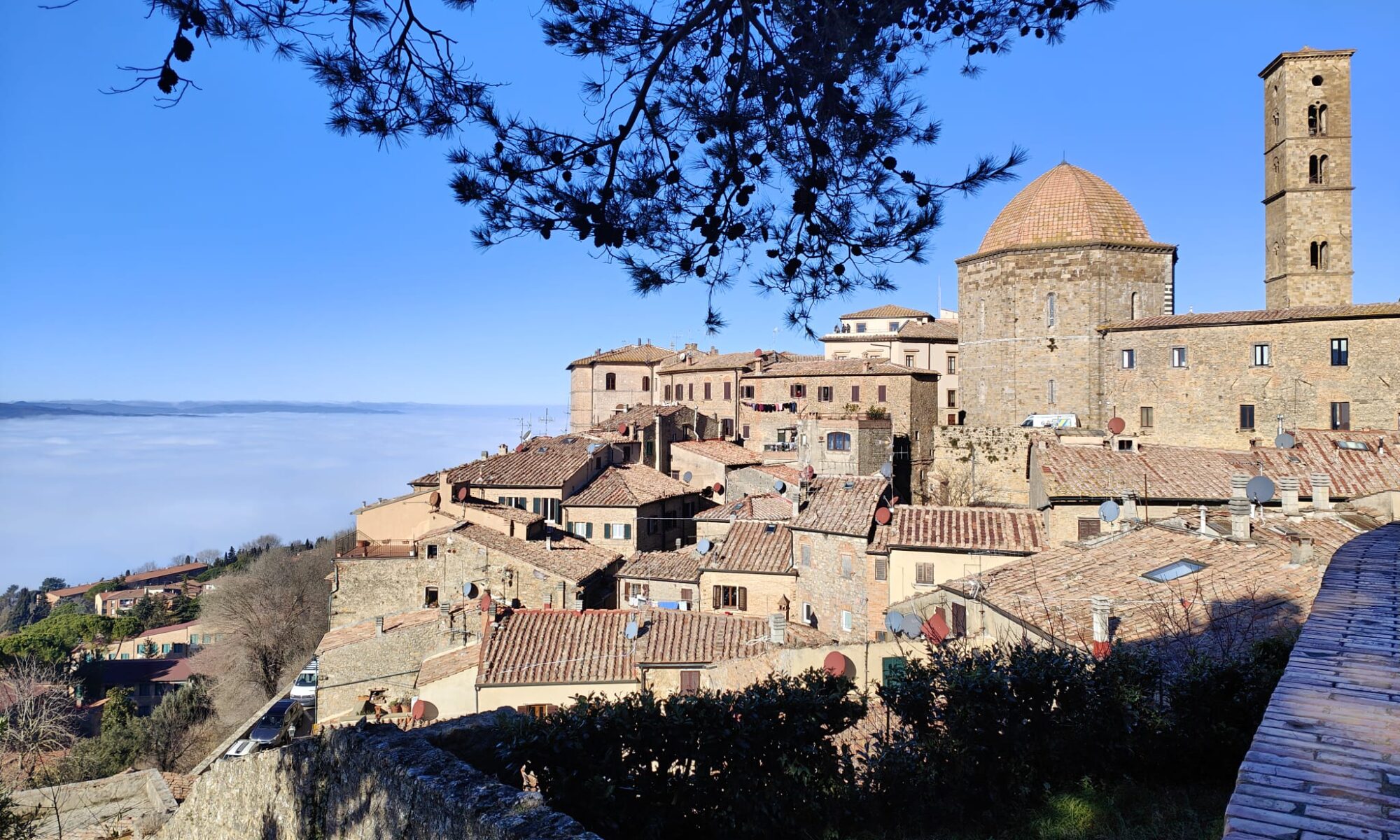
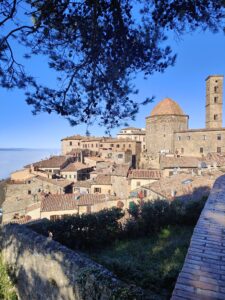
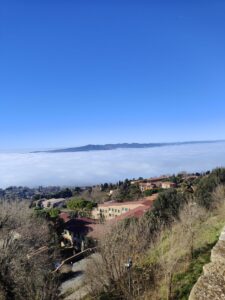

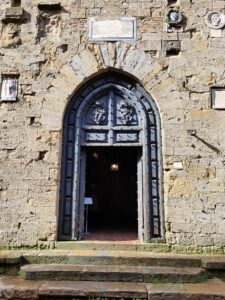



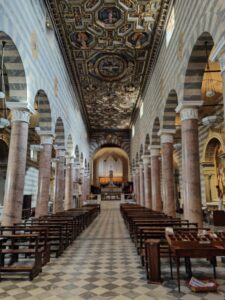
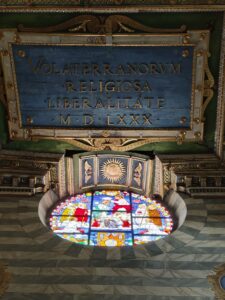

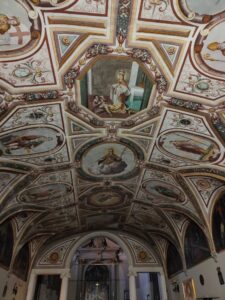


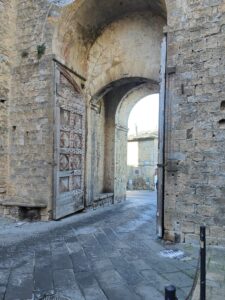
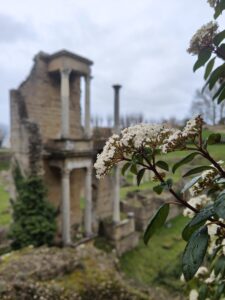



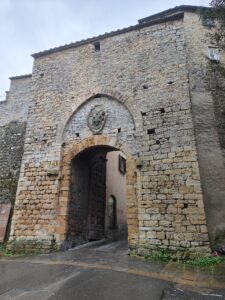

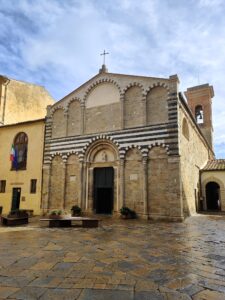
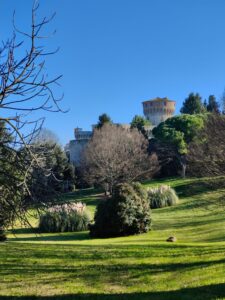
Very well written mark .and a another italian treasure
Is that snow on the ground or a heavy frost? Did you get there early or what? Not many people in the photos (excellent again btw).
Loved the phrase ‘like candy floss to a stick’ and looked it up. It seems as though it is a phrase that is not only used to describe a physical phenomenon as you have done but is used metaphorically to describe the solution to a difficult or messy situation. I learnt something new today.